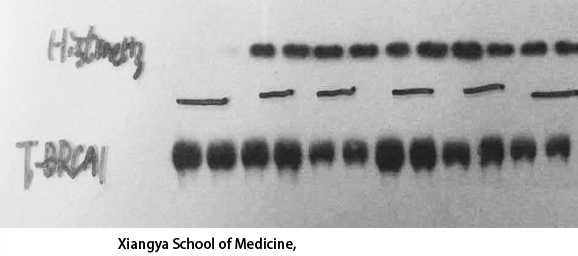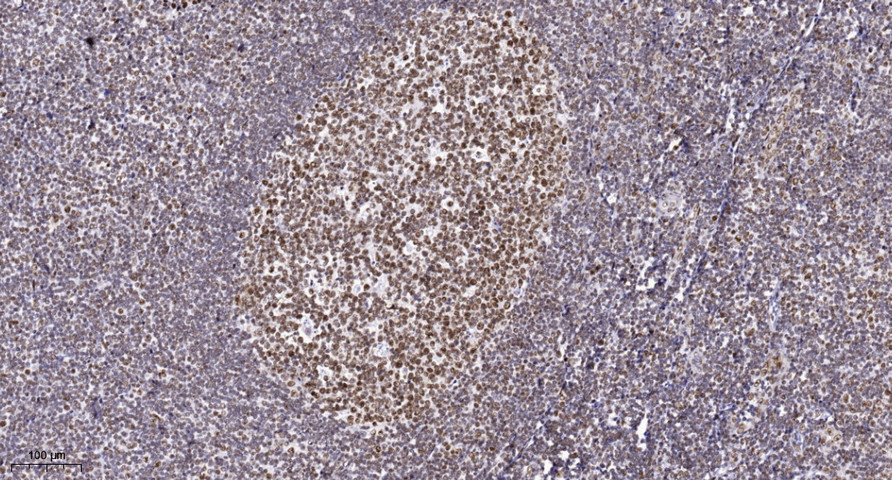BRCA1 Polyclonal Antibody
- Catalog No.:YT0517
- Applications:WB;IHC;IF;ELISA
- Reactivity:Human;Rat;Mouse;
- Target:
- BRCA1
- Fields:
- >>Platinum drug resistance;>>Homologous recombination;>>Fanconi anemia pathway;>>Ubiquitin mediated proteolysis;>>PI3K-Akt signaling pathway;>>MicroRNAs in cancer;>>Breast cancer
- Gene Name:
- BRCA1
- Protein Name:
- Breast cancer type 1 susceptibility protein
- Human Gene Id:
- 672
- Human Swiss Prot No:
- P38398
- Mouse Swiss Prot No:
- P48754
- Immunogen:
- The antiserum was produced against synthesized peptide derived from human BRCA1. AA range:955-1004
- Specificity:
- BRCA1 Polyclonal Antibody detects endogenous levels of BRCA1 protein.
- Formulation:
- Liquid in PBS containing 50% glycerol, 0.5% BSA and 0.02% sodium azide.
- Source:
- Polyclonal, Rabbit,IgG
- Dilution:
- WB 1:500 - 1:2000. IHC 1:100 - 1:300. ELISA: 1:5000.. IF 1:50-200
- Purification:
- The antibody was affinity-purified from rabbit antiserum by affinity-chromatography using epitope-specific immunogen.
- Concentration:
- 1 mg/ml
- Storage Stability:
- -15°C to -25°C/1 year(Do not lower than -25°C)
- Other Name:
- BRCA1;RNF53;Breast cancer type 1 susceptibility protein;RING finger protein 53
- Molecular Weight(Da):
- 208kD
- Background:
- This gene encodes a nuclear phosphoprotein that plays a role in maintaining genomic stability, and it also acts as a tumor suppressor. The encoded protein combines with other tumor suppressors, DNA damage sensors, and signal transducers to form a large multi-subunit protein complex known as the BRCA1-associated genome surveillance complex (BASC). This gene product associates with RNA polymerase II, and through the C-terminal domain, also interacts with histone deacetylase complexes. This protein thus plays a role in transcription, DNA repair of double-stranded breaks, and recombination. Mutations in this gene are responsible for approximately 40% of inherited breast cancers and more than 80% of inherited breast and ovarian cancers. Alternative splicing plays a role in modulating the subcellular localization and physiological function of this gene. Many alternatively spliced transcript varian
- Function:
- disease:Defects in BRCA1 are a cause of genetic susceptibility to breast cancer (BC) [MIM:113705, 114480]. BC is an extremely common malignancy, affecting one in eight women during their lifetime. A positive family history has been identified as major contributor to risk of development of the disease, and this link is striking for early-onset breast cancer. Mutations in BRCA1 are thought to be responsible for 45% of inherited breast cancer. Moreover, BRCA1 carriers have a 4-fold increased risk of colon cancer, whereas male carriers face a 3-fold increased risk of prostate cancer. Cells lacking BRCA1 show defects in DNA repair by homologous recombination.,disease:Defects in BRCA1 are a cause of genetic susceptibility to ovarian cancer [MIM:113705].,disease:Defects in BRCA1 are a cause of susceptibility to familial breast-ovarian cancer type 1 (BROVCA1) [MIM:604370]. Mutations in BRCA1 are
- Subcellular Location:
- Nucleus . Chromosome . Cytoplasm . Localizes at sites of DNA damage at double-strand breaks (DSBs); recruitment to DNA damage sites is mediated by ABRAXAS1 and the BRCA1-A complex (PubMed:26778126). Translocated to the cytoplasm during UV-induced apoptosis (PubMed:20160719). .; [Isoform 3]: Cytoplasm.; [Isoform 5]: Cytoplasm .
- Expression:
- Isoform 1 and isoform 3 are widely expressed. Isoform 3 is reduced or absent in several breast and ovarian cancer cell lines.
- June 19-2018
- WESTERN IMMUNOBLOTTING PROTOCOL
- June 19-2018
- IMMUNOHISTOCHEMISTRY-PARAFFIN PROTOCOL
- June 19-2018
- IMMUNOFLUORESCENCE PROTOCOL
- September 08-2020
- FLOW-CYTOMEYRT-PROTOCOL
- May 20-2022
- Cell-Based ELISA│解您多样本WB检测之困扰
- July 13-2018
- CELL-BASED-ELISA-PROTOCOL-FOR-ACETYL-PROTEIN
- July 13-2018
- CELL-BASED-ELISA-PROTOCOL-FOR-PHOSPHO-PROTEIN
- July 13-2018
- Antibody-FAQs
- Products Images

- The picture was kindly provided by our customer

- Immunohistochemical analysis of paraffin-embedded human tonsil. 1, Antibody was diluted at 1:200(4° overnight). 2, Tris-EDTA,pH9.0 was used for antigen retrieval. 3,Secondary antibody was diluted at 1:200(room temperature, 45min).



